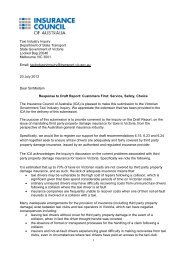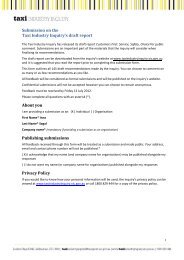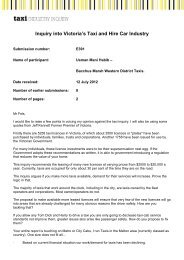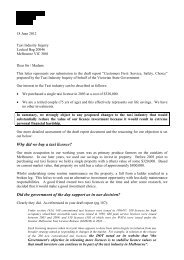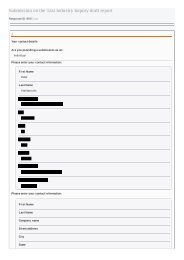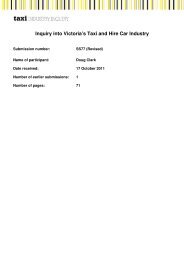Part D â Understanding and improving industry performance (PDF ...
Part D â Understanding and improving industry performance (PDF ...
Part D â Understanding and improving industry performance (PDF ...
You also want an ePaper? Increase the reach of your titles
YUMPU automatically turns print PDFs into web optimized ePapers that Google loves.
In 1999, the Victorian Government entered into a<br />
contract with Cabcharge to use its in-car EFTPOS<br />
system to automate the Multi Purpose Taxi Program<br />
(MPTP), a taxi subsidy scheme for Victorians who are<br />
severely <strong>and</strong> permanently disabled. To facilitate the new<br />
arrangements, the regulator m<strong>and</strong>ated that all taxis be<br />
fitted with a Cabcharge EFTPOS terminal (with some very<br />
limited exceptions). This requirement further cemented<br />
the position of Cabcharge <strong>and</strong> the networks in the<br />
provision of non-cash taxi payments. Secondary EFTPOS<br />
providers have been hampered in breaking into the taxi<br />
market by both the Cabcharge/MPTP partnership <strong>and</strong> by<br />
hardware limitations on taximeters to only interface with<br />
one EFTPOS terminal. 33<br />
In the early 1990s, computer-aided dispatch systems<br />
were introduced, replacing two-way radios <strong>and</strong><br />
dramatically altering the dispatch methods of depots. 34<br />
The linking of inbound calls to cars via more sophisticated<br />
booking <strong>and</strong> dispatch systems further created a<br />
dependence on the emergent networks, as each<br />
individual taxi operator needed the network’s equipment<br />
to access bookings.<br />
Advances in communications infrastructure technologies<br />
led to the digitisation of exchanges, allowing many<br />
organisations to reduce the workforce involved in<br />
answering calls manually. The eventual automation of<br />
incoming calls via the utilisation of Interactive Voice<br />
Recognition (IVR) technologies <strong>and</strong> more recently internet<br />
bookings is now at the point where more than one third<br />
of bookings received by the two major NSPs are h<strong>and</strong>led<br />
without human involvement.<br />
In effect, the major NSPs have entrenched their positions<br />
over time by consolidating their control over network<br />
services via centralised call centre systems <strong>and</strong> emergent<br />
EFTPOS technology. In this way, the networks have<br />
ensured a reliable – <strong>and</strong> profitable – revenue stream<br />
through providing <strong>industry</strong> infrastructure rather than<br />
providing the actual ‘on the ground’ services.<br />
Competition in the booking <strong>and</strong> payments markets<br />
has been constrained until relatively recently;<br />
however, improvements in wireless technologies<br />
<strong>and</strong> the growth in smartphones has started to<br />
open up opportunities for competitors.<br />
11.4. Current regulation of taxi<br />
booking services<br />
11.4.1. Network accreditation<br />
The number of NSPs within an area is not formally<br />
restricted by regulation (other than that NSPs must hold<br />
accreditation). In practice, however, the combination<br />
of zoning, licence conditions <strong>and</strong> regulatory decisionmaking<br />
has resulted in high NSP concentration <strong>and</strong> local<br />
monopolies in many country markets. The requirement<br />
for accreditation of NSPs was introduced as part of<br />
the wider <strong>industry</strong> accreditation scheme in December<br />
2007. In order to be accredited, primary NSPs must<br />
demonstrate that:<br />
• Relevant persons in relation to the organisation are of<br />
good character<br />
• They have the business <strong>and</strong> financial capability to<br />
effectively carry out their activities<br />
• Systems are in place to provide for the safety of<br />
drivers <strong>and</strong> passengers<br />
• They record specified information to enable inspection<br />
<strong>and</strong> audit of their operation<br />
• Systems are in place to ensure that prioritisation of<br />
bookings for wheelchair work<br />
• They have documented disciplinary procedures<br />
for drivers<br />
• A system is in place to ensure that customer<br />
complaints are sufficiently managed <strong>and</strong> resolved.<br />
The rationale for having to demonstrate business <strong>and</strong><br />
financial capability seems questionable <strong>and</strong> is not clearly<br />
related to safety <strong>and</strong> other market failure considerations.<br />
Primary NSPs are issued with an accreditation that<br />
applies for a period of five years. The accreditation<br />
enables them to advertise their services to the public <strong>and</strong><br />
display br<strong>and</strong>ing on the interior <strong>and</strong> exterior of taxis. The<br />
accreditation is issued applicable to a particular zone<br />
<strong>and</strong> restrictions apply to the number of taxis that are<br />
permitted to affiliate with the NSP.<br />
33 The issue is canvassed in greater detail in chapter 12<br />
34 See Smith, Jack (1996), Silver Top: the first 60 years, Silver Top Taxi<br />
Service, Melbourne<br />
232





